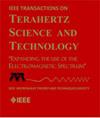A Frequency-Tunable Terahertz Bandpass Filter for Future Communication Systems
IF 3.9
2区 工程技术
Q2 ENGINEERING, ELECTRICAL & ELECTRONIC
IEEE Transactions on Terahertz Science and Technology
Pub Date : 2025-02-14
DOI:10.1109/TTHZ.2025.3542289
引用次数: 0
Abstract
The importance of the terahertz (THz) region in wireless communication is increasing. THz tunable filters are key components for next-generation communication systems. In this article, we have designed a THz narrowband bandpass filter based on a double-layer frequency selective surface (FSS), which is composed of two X-shaped FSSs cascaded together with different geometric parameters. The center frequency of the double-layer structure is located between the center frequencies of the two single-layer FSSs. Based on the principle of inverse design, we employed intelligent algorithms to automatically optimize the structural parameters of the single-layer FSS. We simulated the transmission spectra of both single-layer and double-layer FSSs using finite-difference time-domain. Subsequently, FSSs were fabricated using femtosecond laser micromachining and characterized using time-domain THz spectroscopy. The experimental results are highly consistent with simulations. The designed double-layer filter exhibits a high Q factor and tunability of the center frequency by changing the spacing between the two FSS layers. Finally, based on an equivalent circuit model, we analyzed the transmission phenomenon of the nonequivalent double-layer FSS structure and attributed it to the resonances of equivalent capacitance and inductance between the FSS layers at different spacings. This approach can be applied to design tunable filters for other frequency bands.用于未来通信系统的频率可调太赫兹带通滤波器
太赫兹(THz)区域在无线通信中的重要性日益增加。太赫兹可调谐滤波器是下一代通信系统的关键部件。本文设计了一种基于双层频率选择表面(FSS)的太赫兹窄带带通滤波器,该滤波器由两个x形的FSS级联而成,并具有不同的几何参数。双层结构的中心频率位于两个单层fss的中心频率之间。基于逆设计原理,采用智能算法对单层FSS的结构参数进行自动优化。我们用时域有限差分方法模拟了单层和双层fss的透射光谱。随后,利用飞秒激光微加工技术制备了fss,并利用时域太赫兹光谱对其进行了表征。实验结果与模拟结果高度吻合。所设计的双层滤波器通过改变两层FSS层之间的间距,具有高Q因子和中心频率可调性。最后,基于等效电路模型,分析了非等效双层FSS结构的传输现象,并将其归因于不同间距下FSS层间等效电容和等效电感的共振。这种方法可以应用于设计其他频段的可调谐滤波器。
本文章由计算机程序翻译,如有差异,请以英文原文为准。
求助全文
约1分钟内获得全文
求助全文
来源期刊

IEEE Transactions on Terahertz Science and Technology
ENGINEERING, ELECTRICAL & ELECTRONIC-OPTICS
CiteScore
7.10
自引率
9.40%
发文量
102
期刊介绍:
IEEE Transactions on Terahertz Science and Technology focuses on original research on Terahertz theory, techniques, and applications as they relate to components, devices, circuits, and systems involving the generation, transmission, and detection of Terahertz waves.
 求助内容:
求助内容: 应助结果提醒方式:
应助结果提醒方式:


